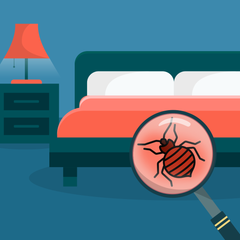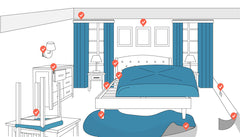 Nowadays, you can find bed bugs almost everywhere. From homes to luxurious hotel rooms, these pesky critters can reach almost any destination simply by hitchhiking on your luggage, clothing, or children’s toys. With the increase in bed bug infestations, you may want to know how to look for bed bugs - whether you are staying in a fancy hotel or you are staying at home.
Nowadays, you can find bed bugs almost everywhere. From homes to luxurious hotel rooms, these pesky critters can reach almost any destination simply by hitchhiking on your luggage, clothing, or children’s toys. With the increase in bed bug infestations, you may want to know how to look for bed bugs - whether you are staying in a fancy hotel or you are staying at home.
Detecting bed bugs can be difficult because these insects are very small and can easily hide in cracks and crevices. Mattresses and beddings are among bed bugs’ favourite spaces to hide. If you are trying to look for them, clusters of black or dark brown spots are a sign that the area you’re checking is infested. They also release a sweet, subtle musty odour, so if you start smelling something like that, you should be wary of a possible bed bug infestation.
Where to Look for Bed Bugs
 Before anything else, you need to know where to look for these critters. Most likely, you’ll find these pests in areas where you spend most of your time. With their flat bodies, they can easily fit into small spaces and hide anywhere. Look for them in your bed, mattress, bed frame, box spring, foot and headboards, as well as other furniture near your bed.
Before anything else, you need to know where to look for these critters. Most likely, you’ll find these pests in areas where you spend most of your time. With their flat bodies, they can easily fit into small spaces and hide anywhere. Look for them in your bed, mattress, bed frame, box spring, foot and headboards, as well as other furniture near your bed.
You can also find them in gaps and cracks on your wall, floor, window sills and door frame. They may also be hiding on carpet edges, especially when they are placed near the walls and are not moved constantly.
As these pests grow in numbers, they will not only be found in common areas where you would look first, but they will start moving to other areas where they won’t be found as easily.
Steps to Take When Looking for Bed Bugs
Follow the steps below and you will most likely find bed bugs like a professional:
- Start by checking your bed.

- Pull back your bedding carefully and look for fecal or blood stains.
- Check the mattress completely and pay attention to the seams, edges and all air holes. If you can turn it, do so to inspect the other side. Don’t forget to check the foot of the bed.
- Do exactly the same when checking the box spring. If it has a gauze protector, remove it to get a good look at the inside. This is the prime spot where bed bugs may be hiding so you should spend more time checking it over. Use a flashlight, magnifying glass and a spatula to check the joints, screw holes, corners, slats and the part where you attach the cover to the frame.
- Check the head and foot boards; look closely at the joints and corners. Make sure that you pull your bed from the wall to have the back side inspected too.
Once this is done, you can move on to looking at other areas.
- Upholstered pieces of furniture
- Carefully removing all pillows and cushions, then inspect each one. Again, focus on looking at the tuffs, seams and piping. Examine the closures as they will likely hide and lay eggs there.
- Check all the seams, lift the skirting, and make sure that you don’t forget to look at the underside. You should also inspect the pleats and don’t forget the seam attaching the skirts to the furniture.
- Move it away from the wall to check the back side.
- If you have someone to help you, flip the furniture upside down to check underneath and inside.
After this, you can proceed with checking other areas.
- Dressers and nightstands

- Remove the contents of the dressers and nightstands and place them inside a large plastic or garbage bag. You can also put them in any container with a lid to prevent the spreading of bed bugs.
- One by one, pull out the drawers and check each of them inside and out. Pay attention to the joints, corners, as well as any grooves where they can hide and lay eggs.
- Again, check all of the joints and corners of the furniture as you don’t want to leave any area unchecked, letting the bed bugs remain while you try to focus on inspecting other areas.
If you have checked everything, come this far, and have not found a single trace of bed bugs, then you don’t have anything to worry about. You’ve checked many of the places where bed bugs are found in homes with bed bug infestation. You can also use this advice when checking other parts of your home or when giving advice to someone worrying about a possible infestation in their home.
If at any point you have spotted a live bed bug, just STOP. Put your inspection to a halt and start thinking about your bed bug control plan. You can use bed bug detectors and monitors to continuously check the presence and activities of these pests.
 If you want to know more about bed bugs traps, detectors, monitors, and other devices to prevent bed bugs, feel free to check bedbugsos.ca. For any concerns, suggestions or inquiries, don’t hesitate to call us or send us an email and we will get back to you as soon as possible.
If you want to know more about bed bugs traps, detectors, monitors, and other devices to prevent bed bugs, feel free to check bedbugsos.ca. For any concerns, suggestions or inquiries, don’t hesitate to call us or send us an email and we will get back to you as soon as possible.

